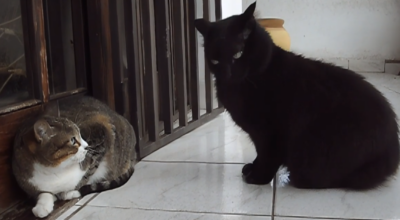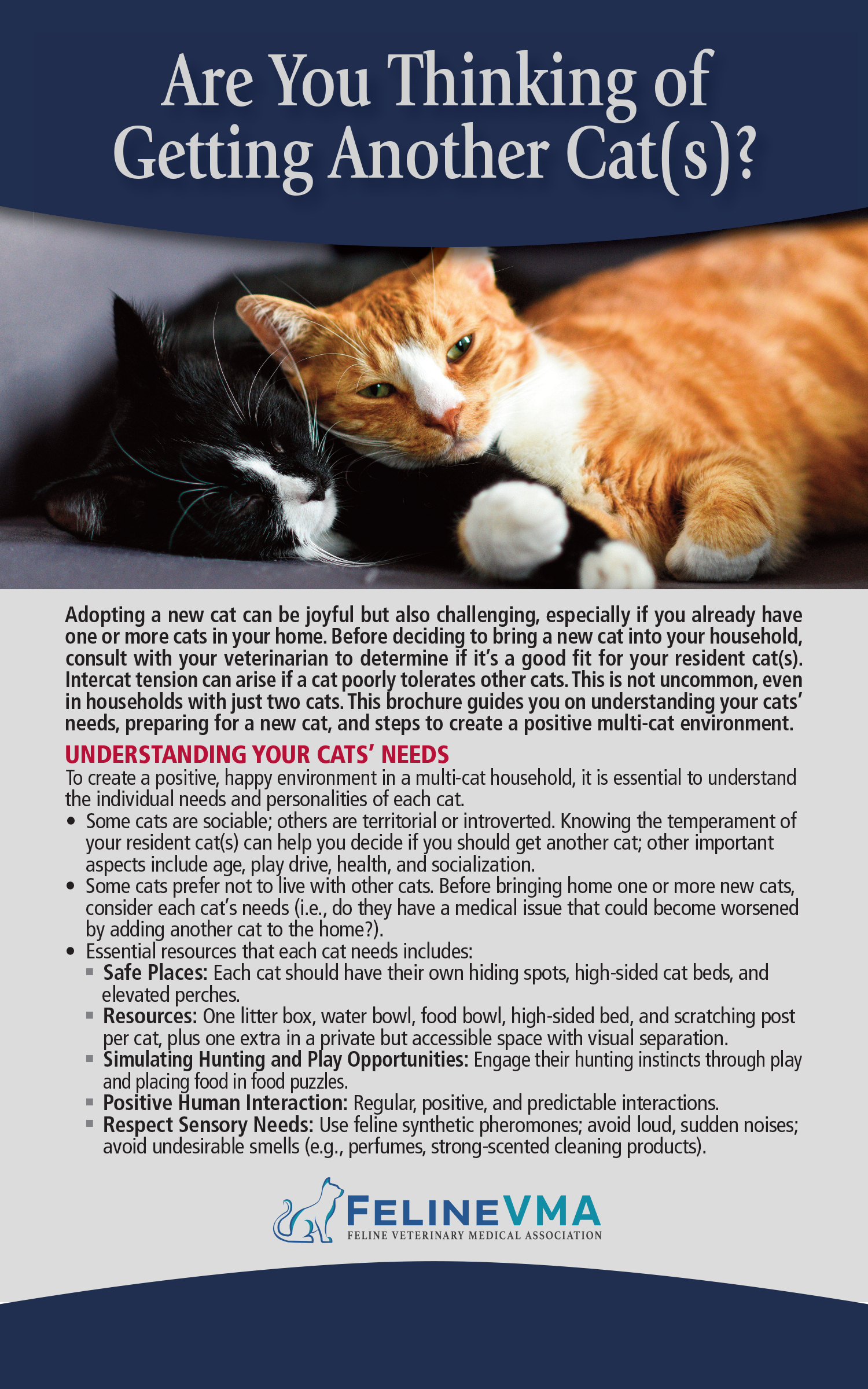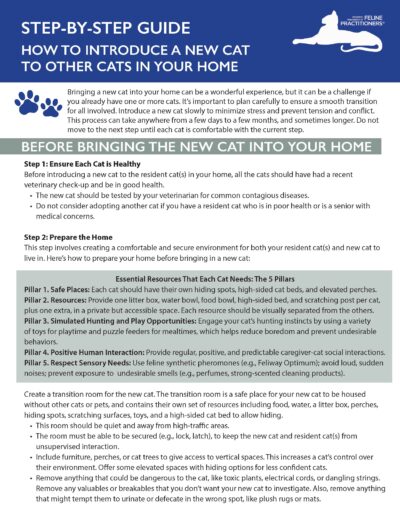Living with multiple cats can be rewarding, but it also comes with challenges, such as intercat tension. Recognizing and addressing this tension is crucial for maintaining the health and happiness of your cats.
What is Intercat Tension?
Intercat tension refers to social tension between cats  and is characterized by poor tolerance of other cats and a lack of friendly interactions by at least one cat in the household toward another cat or cats. This tension can show up in subtle ways, like changes in behavior, prolonged staring, or keeping far apart, or more obvious ways, like chasing, swatting, or fighting. It’s important to recognize and manage this tension to keep a peaceful household. According to a recent survey, between 62.2% and 87.7% of multi-cat households experience intercat tension, and 73.3% of these cases begin with the introduction of a new cat into the home.
and is characterized by poor tolerance of other cats and a lack of friendly interactions by at least one cat in the household toward another cat or cats. This tension can show up in subtle ways, like changes in behavior, prolonged staring, or keeping far apart, or more obvious ways, like chasing, swatting, or fighting. It’s important to recognize and manage this tension to keep a peaceful household. According to a recent survey, between 62.2% and 87.7% of multi-cat households experience intercat tension, and 73.3% of these cases begin with the introduction of a new cat into the home.
 Download Brochure Download Brochure |  Download Step-by-Step Guide Download Step-by-Step Guide |  Download Behavior Modification Handout Download Behavior Modification Handout |
Myths About Intercat Tension
There are several common myths about cats and their social behaviors that can lead to misunderstandings and tension in multi-cat households.
- Myth 1: Cats are solitary creatures. While cats can be independent, they are also capable of forming complex social bonds. Domestic cats have flexible and varied social systems. While some cats prefer to be alone, some can live harmoniously in groups if their needs are met. Since many cats are chosen by their caregiver, some multi-cat homes may not have bonded social groups and are more cohabitees resulting in intercat tension. A Step-by-Step Guide for integrating a new cat in the household is extremely important. Additionally, sometimes increasing the number of cats in a limited space can cause tension.
- Myth 2: Cats’ social organization is based on hierarchy and dominance. Unlike some animals, cats don’t follow strict social orders. Their relationships are more fluid and based on familiarity and individual interactions rather than rigid structure. Intercat tension often arises from an abrupt introduction of a new cat, competition over resources, or changes in the environment, and not from attempts to establish dominance.
- Myth 3: Cats cannot be trained. Cats can be trained using positive reinforcement! Learning processes are universal, and every cat will learn at their own pace. Identifying rewards that each cat prefers, such as treats, play, or petting, can help with training and managing their behavior to reduce tension. A helpful guide to modifying cat behavior can be found here.
- Myth 4: Cats have not been domesticated. Cats have changed quite a bit through the process of living with humans. Their genes are different from their wild ancestors. You can see physical changes too — domesticated cats are often smaller and come in more coat colors than wild cats. Their behavior has also changed, with domesticated cats generally being more docile and showing more affectionate behavior towards humans.
- Myth 5: Cats do not benefit from social interaction or form bonds. Cats can form strong social bonds with other cats and people, benefiting from positive, consistent interactions. Many cats prefer social interaction with people over other types of rewards. In order to create positive experiences, always let the cat dictate how often they want to interact and when they want to end the petting or play session.
- Myth 6: Cats in a social group need to be treated equally. All cats should have their needs met, but they do not have the same needs. Some cats may require more attention or different types of interaction than others. Understanding and providing for each cat’s individual needs can help maintain harmony.
- Myth 7: Cats who appear to be fighting have a broken relationship. ‘Rough-and-tumble’ play can look quite serious, but it is still play. Cats may also use overt expressions, like hissing or non-reciprocated chasing, to end a social encounter without a risk of harm. Occasional conflicts are normal and do not necessarily mean the bond between cats is broken. If these sessions become more frequent or intense (e.g., physical conflict and/or hiding by one cat), an underlying medical problem should be ruled out and behavior support provided by your veterinarian.
- Myth 8: Cats cannot be socialized as adults or outside of the socialization period. While the socialization period (2-9 weeks of age) is critical, cats can still learn new behaviors and adapt to new social situations outside of this period. Don’t believe the idea that a cat’s behavior is set in stone from when they’re young. Cats can be trained and can become more social even as adults.
- Myth 9: Cats can be bad, spiteful, or have an agenda. Cats think in the moment and do not plan out over periods of time so they are not purposefully trying to be “bad” or spiteful. They simply react to what’s happening around them or to the stress they’re feeling. When we misunderstand why cats do certain things, we might respond in ways that don’t help. If we can figure out what’s really causing a cat’s behavior, we’ll be better at dealing with it in a helpful way. You can find causes of intercat tension here.
- Myth 10: Cats get lonely and need a companion. Not all cats require companionship. While some cats may benefit from having a companion, others may experience stress and tension from living with another cat they do not tolerate. Deciding to adopt another cat, and introducing them into the household should be done with careful consideration of each cat’s temperament and the overall environment. A Step-by-Step Guide to this process can be found here.
Causes of Intercat Tension
Several factors can lead to tension between cats:
- Resource Competition: Cats may compete for food, water, litter boxes, playtime, social interactions, and resting places which can cause intercat tension. Other times a cat might block access to these resources and signs of this might be subtle (e.g., staring, stalking, cornering, or even sitting in front of a room’s door or hallway).
- Introduction of a New Cat: New cats can disrupt the existing social and environmental dynamics which can affect many aspects of the household, leading to tension. Additionally, cats that haven’t been properly introduced in the home may create tension between other cat(s).
- Environmental Stressors: Changes in the household, such as new pets, smells, furniture, family members, and renovations can cause stress.
- Health Issues: Pain or illness in one cat can change their behavior and increase tension.
- Lack of Socialization: Cats that haven’t been properly socialized may struggle with cohabitation.
Recognizing Signs of Intercat Tension
It’s essential to recognize both subtle and more obvious signs of tension. Learn more here about how to recognize signs of tension.
Managing and Preventing Intercat Tension
Creating a positive multi-cat household involves understanding and meeting your cats’ needs:
- Environmental Enrichment: Ensure each cat has access to safe places, multiple and separated resources (food, water, litter boxes, resting places), and opportunities for play and predatory behavior.
- Gradual Introductions: When introducing a new cat, use a step-by-step approach to allow for a smooth transition.
- Positive Reinforcement: Reward good behaviors to encourage positive interactions between cats.
- Professional Help: If tension persists, seek advice from your veterinarian as they will want to rule out medical problems, and might refer you to a board-certified veterinary behaviorist.
Understanding and addressing intercat tension is key to ensuring a peaceful and happy multi-cat household. By recognizing the signs and taking proactive steps to manage and prevent tension, you can help your cats live more harmoniously together.

